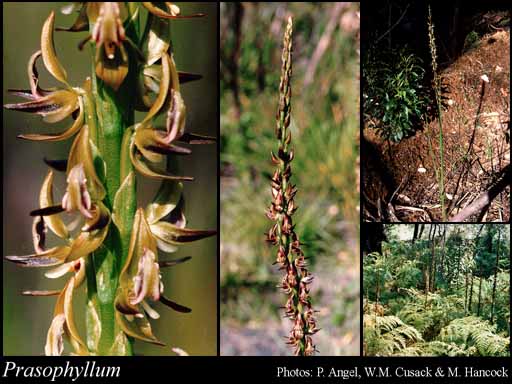- Reference
- Prodr.Fl.Nov.Holland. 317 (1810)
- Name Status
- Current

Scientific Description
Family Orchidaceae.
Habit and leaf form. Herbs. Plants succulent, or non-succulent. Perennial. Leaves basal (sheathing the stem for some distance, then with a free, non-sheathing portion continuing beyond the point where the flower spike bursts through). Tuberous. Helophytic, or mesophytic. Leaves medium-sized to very large; ‘herbaceous’, or leathery; petiolate; simple. Leaf blades entire; solid; terete (hollow); parallel-veined; cross-venulate, or without cross-venules. Leaf blade margins entire. Leaf anatomy. Hairs absent. Stem anatomy. Secondary thickening absent.
Reproductive type, pollination. Fertile flowers hermaphrodite. Unisexual flowers absent. Plants hermaphrodite. Floral nectaries present. Entomophilous (flies, bees, wasps and beetles). Pollination mechanism conspicuously specialized (scent and nectar attract pollinators; the taller growing species are thought to mimic the flower spikes of co-blooming blackboys).
Inflorescence and flower features. Flowers aggregated in ‘inflorescences’. Inflorescence many-flowered. Flowers in spikes. The terminal inflorescence unit racemose. Inflorescences scapiflorous, or not scapiflorous; terminal; stem bracts absent. Flowers prominently bracteate; small to medium-sized; fragrant; very irregular; zygomorphic; not resupinate. The floral asymmetry involving the perianth and involving the androecium. Flowers 3 merous; cyclic; supposedly basically pentacyclic. Perigone tube absent. Perianth of ‘tepals’, or with distinct calyx and corolla; 6; 2 -whorled; isomerous (but zygomorphic); free, or joined; green, or purple, or white, or pink. Calyx (if the outer whorl be so designated) 3, or 5 (by misinterpretation); 1 -whorled; polysepalous, or partially gamosepalous (lateral sepals often partially connate). Corolla (i.e. the members of the inner whorl) 3, or 1 (by misinterpretation); polypetalous; imbricate. Androecium 3, or 1 (by misinterpretation). Androecial members free of the perianth, or adnate; united with the gynoecium (fused with the style to form a column or ‘gynostemium’; column very short, usually with 2 erect lateral appendages); coherent (via the gynostemium); 1 - adelphous; theoretically 2 -whorled. Androecium including staminodes, or exclusively of fertile stamens (by misinterpretation). Staminodes 2 (these anterior, supposedly the abaxial pair of the inner whorl). Stamens 1 (this across the flower from the labellum, i.e. anterior, supposedly representing the outer whorl); reduced in number relative to the adjacent perianth; alterniperianthial (i.e. with reference to the single stamen, across the flower from the labellum); filantherous, or with sessile anthers. Anthers dorsifixed to basifixed; dehiscing via longitudinal slits; introrse; tetrasporangiate; appendaged, or unappendaged. Pollen shed in aggregates; in the form of pollinia. Gynoecium 3 carpelled. The pistil 1 celled. Carpels isomerous with the perianth. Gynoecium syncarpous; eu-syncarpous; inferior. Ovary unilocular; 1 locular. The ‘odd’ carpel anterior (away from the labellum). Gynoecium stylate. Styles 1 (inflexed); apical. Stigmas 1; 3 - lobed (but becoming much modified in form, the apex of the median lobe forming the ‘rostellum’); wet type; papillate; Group III type. Placentation parietal. Ovules not differentiated; in the single cavity 30–100 (i.e. very numerous); non-arillate; anatropous.
Fruit and seed features. Fruit non-fleshy; dehiscent; a capsule. Capsules septicidal, or loculicidal. Fruit 30–500 seeded (i.e. seeds usually very numerous). Seeds endospermic (endosperm development arrested very early), or non-endospermic; minute; without starch. Embryo rudimentary at the time of seed release, or weakly differentiated. Seedling. Seedling collar not conspicuous. Primary root ephemeral.
Geography, cytology, number of species. Native of Australia. Not endemic to Australia.
Additional characters Perianth of 5 dissimilar members and the median inner member modified into the labellum (adaxial sepal appearing abaxial; lateral sepals often as long as or longer than the adaxial sepal; lateral petals not longer than sepals; labellum often shortly clawed, undivided, the apex strongly reflexed; limb with a longitudinal callus plate or ridge). Leaves solitary. Leaves erect. Labellum not motile. Perianth not glossy.